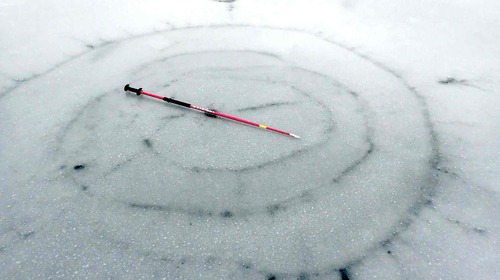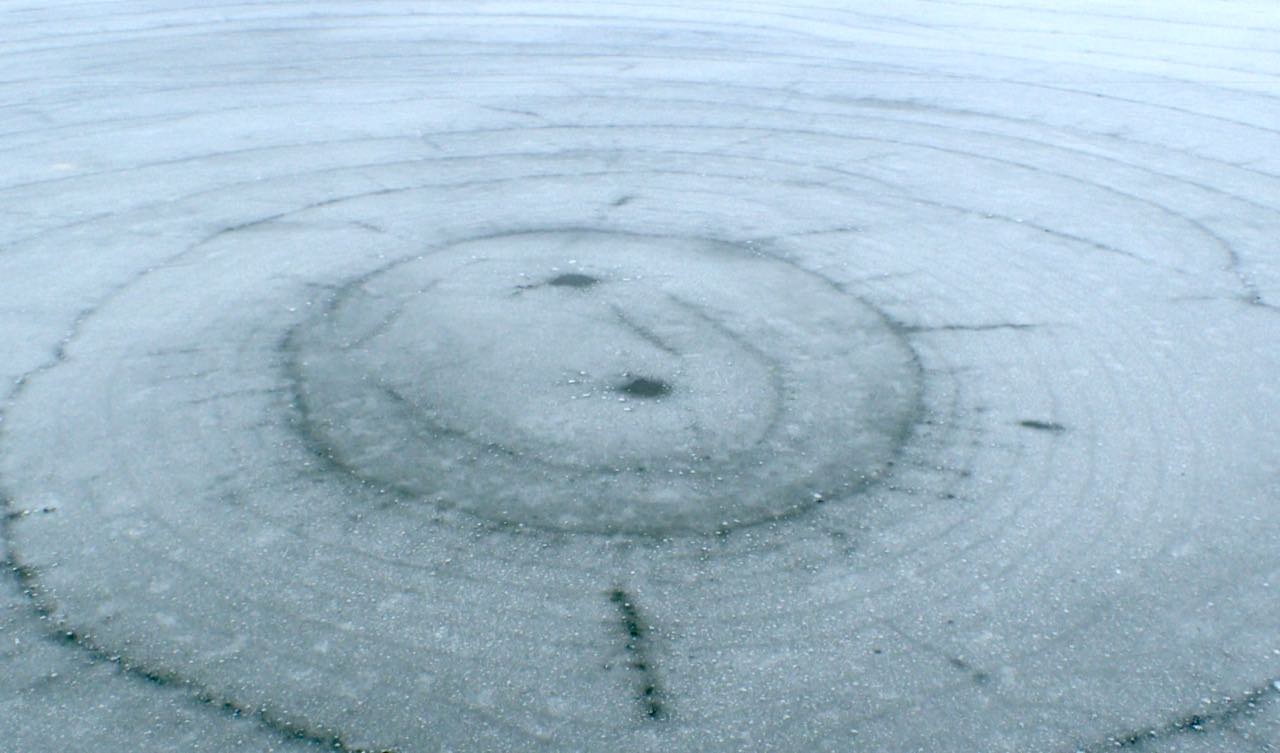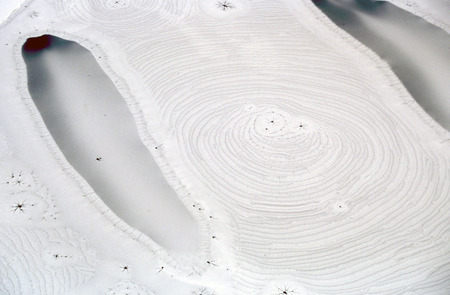Large Ring formations June 2020
This is one of several pages addressing a rarely noticed but spectacular ice formation that shows up on snow ice in certain circumstances. This page is an attempt to show what I believe is the life. This is based on mostly observation of the of the frozen of the stars and rings that make up this story. his may be written with more certitude that is justified. The document is also not well proof read. I suggest looking through the pictures and captions first to get a scene of the subject matter, then the summary and then the detail.
Summary:
Ice rings appear to be the result of an unstable state in a black ice sheet with snow falling on black ice. They start from a Lake Star and start dtrt forming concentric rings. The easily parts of a lake star are from 10 to 2 meters in size. A big ring family can be over 30 M. Lake stars are very common in snow ice. Rings are are less common and often overlooked. They tend to be active when the ice is to week to support peope.
The instablity comes about by dry snow falling on top of an black ice sheet and builds up enough to create a negative freeboard of the black ice sheet.
The process starts when Water comes up through a small hole in the black ice.
As water flows up through the hole it erodes whichincreases the flow rate. The water wicks into the snow and rises a few cm from capilary action.
The water flow in a lake star tends to be dark near the upflow hole where the ice a couple inches belwo the black ice sheet is a little above freezing. Further along the flow path the water flows through is though the slush. It is darcy flow (flow through a bed of particles). It is laminar and has spectacular flow lines (stream lines) made visible by the interstitial air bubbles in the slush.
The slush accumulates by sinking the black ice (increases negative freeboard). The slush forms a round disk that grows radially around the upflow hole. This disk has been named the 'slush domain'. If a slush domain grows toward another slush domain the flow lines will be distorted by potential flow and the disk will not be round.
In certain conditions Lake Stars grow evolve into Ice Rings.
Most of the strength of the ice sheet is in the black ice layer. When the weight of the snow and water gets high enough the ice sheet breaks
Thin plate theory shows that the maximum stress will be in the black ice layer under the outside edge of the the slush disk (slush domain).
****************************************************************************************
At Shelburne Pond VT in 2018 the first fracture is a disk with the upflow hole at the center and a diameter or of 1.5 meters in diameter. The following concentric rings are a little closer together.

The first ring is a rupture in the ice sheet under the radially growing slush domain. The dry snow probably probably does not move once it lands on top of the ice sheet. It is likely that the water that mixes with the dry snow form slush comes from the ring rupture rather than the upflow hole at the center of the initial star.
A well developed ring family can grow to more than 20 meters in diameter.
In above picture the circles are the ring ruptures. The radial lines flowing out from the ring ruptures are flow paths for water flowing out of the ruptures to the slush domain
The out flow is most likely a combination of gravity flow and capilary rise. The force that creates the ruptures is most likely from the weight water flowing into dry snow at the radially growing slush domain.
The water gets on top of the black ice sheet at the ring rupture. That crack is a vertical crack that is seen as circular circular from above. The water path through the black ice sheet is probably small irregularities at the crack face.
************************************************************************************
Ice Arcs are rings that are stopped by the sush domains of adjacent ring families. They are partial rings and can grow to over 30 M in length. In general, most ring families become arcs when they are completely blocked by adjacent slush domains or the shore.
*****************************************************************************************
*****************************************************************************************
Another look at the ice rings.

The above picture is from 2018, Shelburne Pond. The faint rings average roughly 6 cm apart
I talked to Tom Shevenell about what the faint rings might be about. He suggested that they might be from a contraction process. Shrinkage can come from the ice in the slush melting from 0.916 density ice to 1.0 density ice. The slush could have also drained a little leaving some free volume that end up in the faint cracks.
It is likely that th dark rings are a rupture feature as described elsewhere. The faint lines are most likely a shrinkage feature. The radial dark lines that go part way from the inner to the outer ring.
The radial dark lines are dark feeder lines. The darkness comes about because there is no slush and there are not any air bubbles in the passage. They appear to be moving water from the inside ring rupture to the edge of the slush domain being formed by this water mixing with dry snow on top of the black ice sheet. The Darcy flow lines are not as visible as they are in some other pictures. This is probably due to more interstitial bubbles in the slush.
The circular lines give the illusion that the surface is raised like a contour line. This is not the case. It is only an optical illusion. Usually when you are standing on rings there has been enough thawing to to Zamboni and flatten the surface of the ice sheet.
****************************************************************************************
This image was taken by Rick Paridis in 2002.

Features:
The ring family is obvious on the right center of the image. it has three lake stars near or in the first ring.
Snowfall slush covered holes.The smooth features on the right and left of the image are probably snow fall slush that formed where there was a large elongated hole in the ice sheet. The shading with darker grey on the left side and especially near the top. That is probably the effect of a left side light wind moving the slush toward the right.
The snowfall slush covered holes are surrounded a band of linear lake stars and white darcy flow slush. The linear stars bring water from the edge of the slush covered hole hole (where there is an upflow hole) to the white band of darcy slush (slush that forms by water mixing with dry on top of the ice sheet.
***********************************************************************************
************************************************************************************
Rings occur on snow ice with relatively thin black ice at the bottom of the ice sheet. They are often not noticed as they ice is too thin to walk on. They generally freeze thicker on a subsiquent cold spells or break up if it gets warm. What we see most is thickend black ice on the bottom of the black ice sheedt. The formations are probably active for a few days at most. If more snow arrives and evolved into snow ice it may hide the formations.
thouights from July 27, 2020
Ice rings occur when the ice is thin in a spell of near freezing weather so the close proximity of ice, water, dry snow and slush can maintain a temperature very near freezing. It looks likely that teh conditions will involve snow falling onto thin ice sheet (not more than a couple inches???).
A cold spell after the ring formation stops can thicken an ice sheet or melt off the top layer.
Energics:
It looks like the amount of vertical travel of the ice surface (top of the ice sheet) is probably only few cm. capulary rise of water of water into snow is a few cm. I attempted to look at a ring rupture with crossed polars . The experment did not go all that well but it did suggest the shifting of the plates on each side of the ring rupture was about 10 or so cm. Next time we have rings on a sheet that is thick enough to walk on, we should saw off sections of the ice sheet to get a better understanding of the structure of the rupture.
Timing
From what we saw in the mid-storm pictures of Norway Pond shows ring/arc formation was probably compleete by a day and could have been considerably less than that. Individual rings/arcs might form in under an hour.
